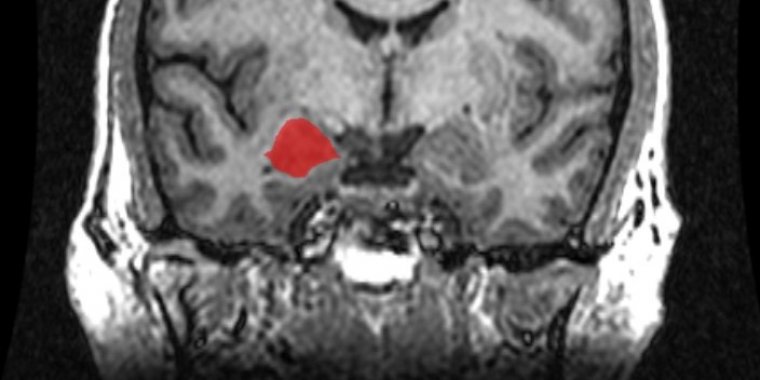| Health / Health News |
Researchers identify area of the amygdala involved in taste aversion
Researchers from the University of Granada, together with scientists from the Autonomous University of Baja California (UABC), have identified the area of the brain that is directly involved in our aversion to toxic, spoiled or poisonous foods.

MRI coronal view of the right amygdala. ![]()
The rejection of foods that our brain associates with gastric toxicity and poisoning is characteristic of what experts call taste aversion learning. Its impact on eating behaviour is well documented, but the brain connections involved in each stage of the development of taste aversion are still unknown, particularly with regard to the development of taste memory and its association with stomach problems.
Building on previous studies that pointed towards the involvement of the amygdala in taste aversion, the UGR researchers focused on this small structure located in the limbic region of both hemispheres which is involved in learning and memory, as well as emotional processing.
Both vertebrates and invertebrates have the ability to recognise potentially toxic flavours, thereby avoiding poisoning.
The taste aversion learning model is widely used in animal research to explore learning and memory. The experiment involves exposing the animal to a new non-toxic taste and, a few minutes later, inducing gastrointestinal upset by administering an injection of a harmful substance.
The animal thereby learns to associate the taste with stomach upset. This taste aversion not only induces rejection and avoidance, but also loss of appetite.
During the study, the researchers intentionally damage the three main nuclei of the amygdala to determine which region is responsible for the acquisition of conditioned taste aversion (CTA). Using this method, the researchers were able to determine the specific area that regulates the magnitude of taste aversion, called the basolateral complex.
The amygdala is part of the limbic system, a brain region associated with emotions and learning involved in negative emotional processing, such as fear and disgust, as well as in the processing of memories that contain emotions. The structure of the limbic system is composed of a series of groups of neurons including central, medial and basolateral nuclei, among others.
Of the four groups of animals under study, a reduction in aversion was only observed in the group with lesions in the basolateral complex of the amygdala.
According to the researchers, when a particular taste is accompanied by sickness attributable to the food with the taste, such as is the case with poisonous mushrooms, a conditioned taste aversion (CTA) arises following a single experience of consuming the substance.
This association between taste and symptoms of poisoning also arises even if the stomach upset occurs several hours after having eaten. This is because the time needed to digest the food causes a delay in the association between the stimuli.
Conditioned taste aversion (CTA) may form part of the mechanisms involved in anorexia and other similar disorders, particularly if associations arise between food and discomfort, or even with negative emotions. (University of Granada)
YOU MAY ALSO LIKE





